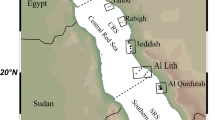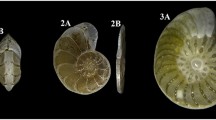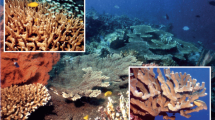Abstract
In several parts of the world, mytilid mussels, Mytilus spp., are infected with pathogenic, single-celled, photosynthetic algae belonging to the genus Coccomyxa. The posterior shell edge of heavily infected mussels becomes considerably thickened with an extra shell material. Also, the external shell surface is usually eroded as a result of the microboring activity of endolithic cyanobacteria. We compared the number of bioeroded shells, the bioerosion degree, and the number of badly eroded shells, in uninfected and Coccomyxa-infected Mytilus spp. from the Lower St. Lawrence Estuary, Québec, Canada. The thickness of prismatic and nacreous layers was measured. The epibionts (pink calcareous algae, crustose brown algae, and barnacles) which encrusted surface of studied shells, were counted. Epibionts did not occur frequently and their possible relationship with the partners of a three-way symbiosis, Coccomyxa sp. – Mytilus spp. – endolithic cyanobacteria, has been neglected. We suggest that the mussel provides the alga Coccomyxa a protected space and metabolic carbon for photosynthesis. The alga stimulates shell thickening, and this protects mussel against ocean acidification and predators. The endolithic cyanobacteria remove black-colored periostracum providing the mussel and alga with an increased ability to survive during sunny days when exposed at low tide. The eroded shells become more translucent which encourages alga photosynthesis. However, shell degradation caused by endolithic cyanobacteria is a possible reason for the death of the Coccomyxa-infected mussels at the studied sites.


Similar content being viewed by others
Data availability
All data generated or analyzed in this study are included in the article.
References
Darienko T, Gustavs L, Eggert A, Wolf W, Pröschold T (2015) Evaluating the species boundaries of green microalgae (Coccomyxa, Trebouxiophyceae, Chlorophyta) using integrative taxonomy and DNA bar-coding with further implications for the species identification in environmental samples. PLoS One 10:e0127838. https://doi.org/10.1371/journal.pone.0127838
Fitzer SC, Vittert L, Bowman A, Kamenos NA, Phoenix VR, Cusack M (2015) Ocean acidification and temperature increase impact mussel shell shape and thickness: problematic for protection? Ecol Evol 21:4875–4884
Gehman A-LM, Harley CDG (2019) Symbiotic endolithic microbes alter host morphology and reduce host vulnerability to high environmental temperatures. Ecosphere 10(4):e02683. https://doi.org/10.1002/ecs2.2683
Kaehler S, McQuaid CD (1999) Lethal and sub-lethal effects of phototrophic endoliths attacking the shell of the intertidal mussel Perna perna. Mar Biol 135:497–503
Laihonen P, Furman ER (1986) The site of settlement indicates commensalism between bluemussel and its epibiont. Oecologia (Berlin) 71:38–40
Leclerc R (1987) Guide d’identification des algues marines de l’estuaire du Saint-Laurent, ed. Groupe d’animation en sciences naturelles du Québec, 180 p
Mortensen S, Harkestad LS, Stene R-O, Renault T (2005) Picoeucaryot alga infecting blue mussel Mytilus edulis in southern Norway. Dis Aquat Org 63:25–32
Nash TH (2008) Lichen biology. Cambridge University Press, Cambridge
Ponnudurai R, Heiden SE, Sayavedra L, Hinzke T, Kleiner M, Hentschker C, Felbeck H, Sievert SM, Schlüter R, Becher D, Schweder T, Markert S (2020) Comparative proteomics of related symbiotic mussel species reveals high variability of host–symbiont interactions. ISME J 14:649–656. https://doi.org/10.1038/s41396-019-0517-6
Richardson DHS, Jackson Hill D, Smith DC (1968) Lichen physiology. XI. The role of the alga in determining the pattern of carbohydrate movement between lichen symbionts. New Phytol 67:469–486
Rossbach S, Saderne V, Anton A, Duarte CM (2019) Light-dependent calcification in Red Sea giant clam Tridacna maxima. Biogeosciences 16:2635–2650. https://doi.org/10.5194/bg-16-2635-2019
Sokolnikova Y, Magarlamov T, Stenkova A, Kumeiko V (2016) Permanent culture and parasitic impact of the microalga Coccomyxa parasitica, isolated from horse mussel Modiolus kurilensis. J Invetebr Pathol 140:25–34
Zardi GI, Nicastro KR, McQuaid CD, Gektidis M (2009) Effects of endolithic parasitism on invasive and indigenous mussels in a variable physical environment. PLoS One 4(8):e6560. https://doi.org/10.1371/journal.pone.0006560
Zhao L, Zuykov M, Tanaka K, Shirai K, Anderson J, McKindsey CW, Deng Y, Spiers G, Schindler M (2019) New insight into light-enhanced calcification in mytilid mussels, Mytilus sp., infected with photosynthetic algae Coccomyxa sp.: δ13C value and metabolic carbon record in shells. J Exp Mar Biol Ecol 520. https://doi.org/10.1016/j.jembe.2019.151211
Zuykov M, Belzile C, Lemaire N, Gosselin M, Dufresne F, Pelletier E (2014) First record of the green microalgae Coccomyxa sp. in blue mussel Mytilus edulis (L.) from the lower St. Lawrence estuary (Québec, Canada). J Invertebr Pathol 120:23–32
Zuykov M, Anderson J, Archambault P, Dufresne F, Pelletier E (2018a) Mytilus trossulus and hybrid (M. edulis-M. trossulus) – new hosts organisms for pathogenic microalgae Coccomyxa sp. from the estuary and northwestern gulf of St. Lawrence, Canada. J Invertebr Pathol 153:145–146
Zuykov M, Anderson J, Pelletier E (2018b) Does photosynthesis provoke formation of shell deformity in Coccomyxa-infested wild mytilid mussels Mytilus spp.? - a conceptual model and research agenda. J Exp Mar Biol Ecol 505:9–11
Zuykov M, Allam B, Gosselin M, Archambault P, Spiers G, Schindler M (2020) First report of signs of infection by Coccomyxa-like algae in wild blue mussels, Mytilus spp., in the Gulf of Maine (USA, Maine). J Fish Dis 00:1–4. https://doi.org/10.1111/jfd.13172
Zuykov M, Kolyuchkina G, Spiers G, Gosselin M, Archambault P, Schindler M (2021) Pre-exposure to Cu2+ and CuO NPs leads to infection of caged blue mussels, Mytilus edulis L., by pathogenic microalga: pilot study in the lower St. Lawrence estuary (Québec, Canada). Mar Pollut Bull 166. https://doi.org/10.1016/j.marpolbul.2021.112180
Acknowledgements
The authors thank Drs. W. Adey and M. Cusson for epibionts identification, T. Goto for assistance with shell section preparation. We appreciate Sidney Pierce’s, David Richardson’s, and two anonymous reviewers support during manuscript revision. MZ was supported by Japan Society for the Promotion of Science (JSPS) Fellowship (PE20004) and the Queen Elizabeth II Graduate Scholarships in Science and Technology (QEII-GSST). MS was supported by a Natural Sciences and Engineering Research Council of Canada (NSERC) discovery grant.
Funding
This research did not receive any specific grant from funding agencies in the public, commercial, or not-for-profit sectors.
Author information
Authors and Affiliations
Contributions
MZ, JA, MG and PA contributed to the study conception and design, and performed the field research; MZ wrote the first version of the manuscript; GK, LZ and KS analyzed the data and worked with the literature; MG, PA and MS administrated the project. All the authors edited the manuscript.
Corresponding author
Ethics declarations
Conflict of interest
The authors report no conflicts of interest.
Consent to participate
Not applicable.
Consent for publication
Not applicable.
Code availability
Not applicable.
Additional information
Publisher’s note
Springer Nature remains neutral with regard to jurisdictional claims in published maps and institutional affiliations.
Rights and permissions
About this article
Cite this article
Zuykov, M., Anderson, J., Kolyuchkina, G. et al. New three-way symbiosis: an eukaryotic alga, a blue mussel, and an endolithic cyanobacteria. Symbiosis 84, 163–169 (2021). https://doi.org/10.1007/s13199-021-00777-1
Received:
Accepted:
Published:
Issue Date:
DOI: https://doi.org/10.1007/s13199-021-00777-1




